Post-Fire Restoration of the Vegetation at the Cemetery of the Tatoi Estate Historical Site
Abstract
1. Introduction
- Minimum distance between tree crowns: 4 m;
- Maximum horizontal coverage of tree stands: 15 m;
- Minimum distance between tree stands equal to the diameter of the largest stand;
- Maximum horizontal coverage of shrub stands: 5 m;
- Minimum distance between shrubs equal to the diameter of the largest shrub or stand and at least 2 m;
- Minimum distance between buildings and tree or shrub crowns: 5 m;
- Ground cover with phrygana can be continuous;
- Shrubs may exist under trees, but there must be a vertical break in crown continuity. The gap between the tree crown base and the shrub top must be three times the shrub height;
- Pruning tree branches up to a height of 2.5 m.
- Restoring the natural environment through the re-establishment of vegetation, particularly the Aleppo pine and cypress species;
- Revitalizing historical landmarks, such as the cemetery’s cypress-lined pathways;
- Enhancing fire resilience through strategic vegetation management;
- Restoring the original historical pathways.
2. Materials and Methods
2.1. Study Area
2.2. Historical Background
2.3. Cemetery Vegetation and Paths
2.4. Measurements
3. Results
- Restoring the natural environment: This involves re-establishing the vegetation formation and plant species, particularly the Aleppo pine and cypress tree layer;
- Restoring historical landscape landmarks: Specifically, the cypress-lined pathways within the cemetery;
- Improving fire protection conditions through vegetation fragmentation;
- Restoring the historical paths.
3.1. Vegetation Restoration
- Maintain a minimum distance between tree crowns of 4 m;
- Ensure a maximum horizontal coverage of tree stands at 15 m;
- Set a minimum distance between tree stands equal to the diameter of the largest stand;
- Limit the maximum horizontal coverage of shrub stands to 5 m;
- Set a minimum distance between shrubs equal to the diameter of the largest shrub or stand and at least 2 m;
- Maintain a minimum distance of 5 m between buildings and the crowns of trees or shrubs;
- Allow continuous ground cover with phrygana;
- Permit shrubs under trees but ensure a vertical break in crown continuity. The gap between the tree crown base and the top of the shrubs must be three times the shrub height;
- Prune tree branches up to a height of 2.5 m.
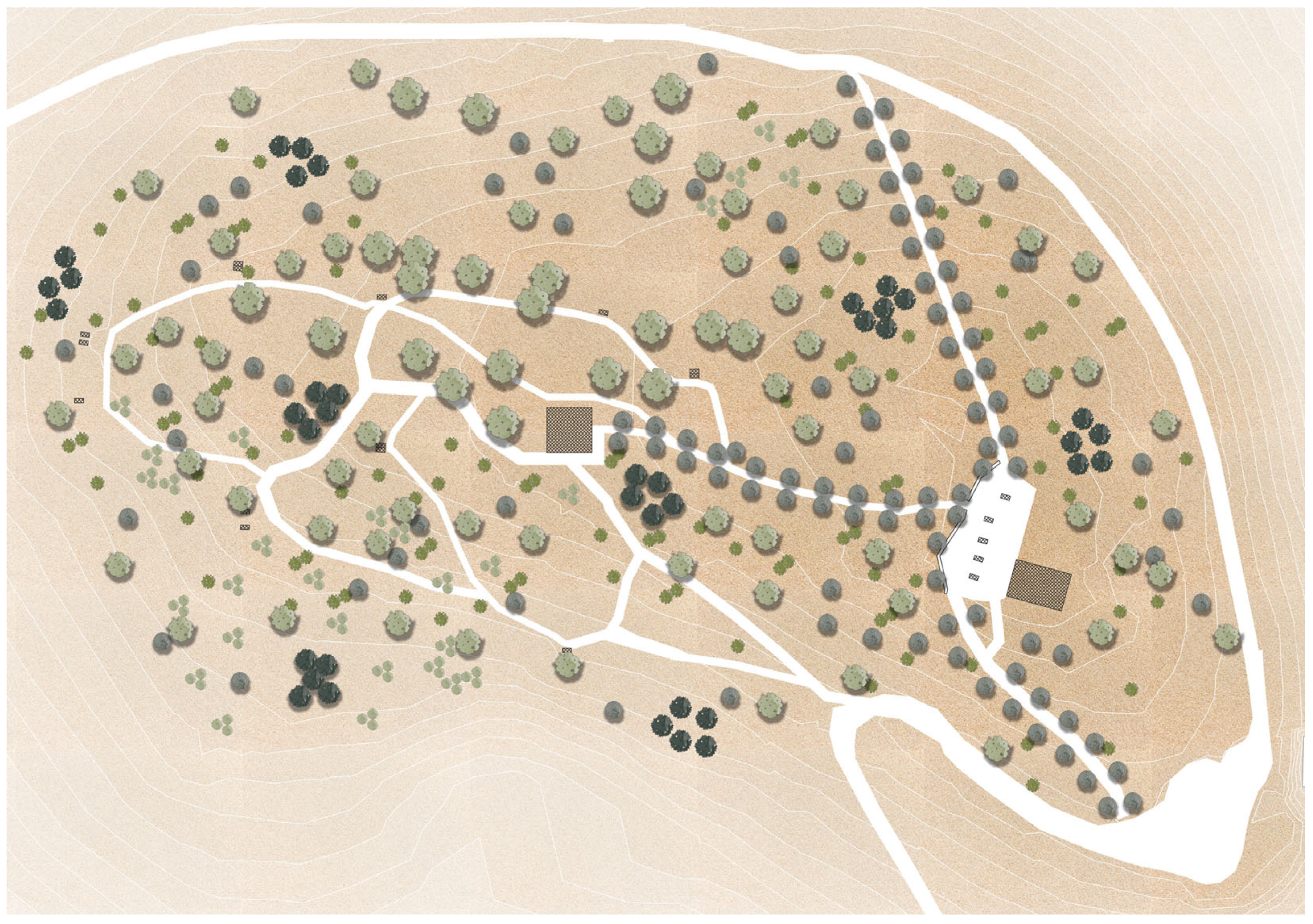
- In the area where the vegetation patch survives, covering approximately 4500 m2, thinning of the vegetation patch was proposed, reducing the tree density to achieve the desired fuel break vegetation structure;
- In the area where there was high natural regeneration, it was proposed to aid the natural regeneration, which is considered the best restoration method, in combination with planting a few large-sized Aleppo pine seedlings to immediately improve the appearance of the area;
- In the area where natural regeneration has been disrupted due to recent landscaping work (2023), it was proposed to plant seedlings of the same age as the naturally regenerated seedlings.
3.2. Restoration and Conservation of the Historical Pathways
4. Discussion
5. Conclusions
Author Contributions
Funding
Institutional Review Board Statement
Informed Consent Statement
Data Availability Statement
Conflicts of Interest
References
- Vallejo, V.R.; Arianoutsou, M.; Moreira, F. Fire Ecology and Post-Fire Restoration Approaches in Southern European Forest Types. In Post-Fire Management and Restoration of Southern European Forests; Moreira, F., Arianoutsou, M., Corona, P., De las Heras, J., Eds.; Managing Forest Ecosystems; Springer: Dordrecht, The Netherlands, 2012; Volume 24. [Google Scholar] [CrossRef]
- de las Heras, J.; Moya, D.; Vega, J.A.; Daskalakou, E.; Vallejo, V.R.; Grigoriadis, N.; Tsitsoni, T.; Baeza, J.; Valdecantos, A.; Fernández, C.; et al. Post-Fire Management of Serotinous Pine Forests. In Post-Fire Management and Restoration of Southern European Forests; Moreira, F., Arianoutsou, M., Corona, P., De las Heras, J., Eds.; Managing Forest Ecosystems; Springer: Dordrecht, The Netherlands, 2012; Volume 24. [Google Scholar] [CrossRef]
- Thanos, C.A.; Daskalakou, E.N. Reproduction in Pinus halepensis and P. brutia. In Ecology, Biogeography and Management of Pinus halepensis and P. brutia Forest Ecosystems in the Mediterranean Basin; Ne’eman, G., Trabaud, L., Eds.; Backhuys Publishers: Leiden, The Netherlands, 2000; pp. 79–90. [Google Scholar]
- Tsitsoni, T. Conditions Determining Natural Regeneration after Wildfires in the Pinus halepensis (Miller, 1768) Forests of Kassandra Peninsula (North Greece). For. Ecol. Manag. 1997, 92, 199–208. [Google Scholar] [CrossRef]
- Zagas, T. Research on the Natural Regeneration of Pinus halepensis after a Forest Fire in the Mount Pateras Area. Sci. Ann. Sch. For. Nat. Environ. Aristotle Univ. Thessalon. 1987, 30, 303–327. [Google Scholar]
- Moya, D.; de las Heras, J.; López-Serrano, F.R.; Leone, V. Optimal Intensity and Age of Management in Young Aleppo Pine Stands for Post-Fire Resilience. For. Ecol. Manag. 2008, 255, 3270–3280. [Google Scholar] [CrossRef]
- Tsitsoni, T.; Ganatsas, P.; Zagas, T.; Tsakaldimi, M. Dynamics of Post-Fire Regeneration of Pinus brutia Ten. in an Artificial Forest Ecosystem of Northern Greece. Plant Ecol. 2004, 171, 165–174. [Google Scholar] [CrossRef]
- Zagas, T.; Ganatsas, P.; Tsitsoni, T.; Tsakaldimi, M. Post-Fire Regeneration of Pinus halepensis Mill. Stands in the Sithonia Peninsula, Northern Greece. Plant Ecol. 2004, 171, 91–99. [Google Scholar] [CrossRef]
- Karali, A.; Hatzaki, M.; Giannakopoulos, C.; Roussos, A.; Xanthopoulos, G.; Tenentes, V. Sensitivity and Evaluation of Current Fire Risk and Future Projections Due to Climate Change: The Case Study of Greece. Nat. Hazards Earth Syst. Sci. 2014, 143, 143–153. [Google Scholar] [CrossRef]
- Vasilakos, C. Remote Sensing, Artificial Intelligence, and Geographic Information Systems in Forest Fire Risk Assessment. Ph.D. Thesis, University of the Aegean, Mytilene, Greece, 2007. [Google Scholar]
- Mouillot, F.; Rambal, S.; Joffre, R. Simulating Climate Change Impacts on Fire Frequency and Vegetation Dynamics. Glob. Change Biol. 2002, 8, 423–437. [Google Scholar] [CrossRef]
- Dimitrakopoulos, A. Mediterranean Fuel Models and Potential Fire Behaviour in Greece. Int. J. Wildland Fire 2002, 11, 127–130. [Google Scholar] [CrossRef]
- Mitsopoulos, I. Analysis and Management of Canopy Fires in Aleppo Pine Forests. Ph.D. Thesis, Aristotle University of Thessaloniki, Thessaloniki, Greece, 2005. [Google Scholar]
- Graham, R.T. Hayman Fire Case Study; General Technical Report RMRS-GTR-114; United States Department of Agriculture (USDA), Forest Service, Rocky Mountain Research Station: Fort Collins, CO, USA, 2003; p. 396.
- Scott, J.H.; Reinhardt, E.D. Assessing Crown Fire Potential by Linking Models of Surface and Crown Fire Potential; Research Paper RMRS-29; USDA, Forest Service, Rocky Mountain Research Station: Fort Collins, CO, USA, 2001; p. 59.
- Alexander, M.E. Fire Behavior as a Factor in Forest and Rural Fire Suppression; Forest Research Bulletin, Forest and Rural Fire Scientific and Technical Series No. 5; New Zealand Forest Research Institute Limited: Wellington, New Zealand, 2000; p. 28. [Google Scholar]
- Albini, F.A.; Stocks, B.J. Predicted and Observed Rates of Spread of Crown Fires in Immature Jack Pine. Combust. Sci. Technol. 1986, 48, 65–76. [Google Scholar] [CrossRef]
- Wade, D.D.; Ward, D.E. An Analysis of the Air Force Bomb Range Fire; Research Paper SE-105; United States Department of Agriculture (USDA), Forest Service, Southeast Forest and Range Experiment Station: Asheville, NC, USA, 1973; p. 38.
- Cruz, M.G. Modeling the Initiation and Spread of Crown Fires. Master’s Thesis, University of Montana, Missoula, MT, USA, 1999; p. 162. [Google Scholar]
- Peterson, D.L.; Johnson, M.C.; Agee, J.K.; Jain, T.B.; McKenzie, D.; Reinhardt, E.D. Forest Structure and Fire Hazard in Dry Forests of the Western United States; General Technical Report GTR-628; USDA, Forest Service, Pacific Northwest Research Station: Portland, OR, USA, 2005; p. 30.
- Fiedler, C.E.; Keegan, C.E.; Woodall, C.W.; Morgan, T.A. A Strategic Assessment of Crown Fire Hazard in Montana: Potential Effectiveness and Costs of Hazard Reduction Treatments; General Technical Report GTR-622; United States Department of Agriculture (USDA) Forest Service, Pacific Northwest Research Station: Portland, OR, USA, 2004; p. 48.
- Pollet, J.; Omi, P. Effect of Thinning and Prescribed Burning on Crown Fire Severity in Ponderosa Pine Forests. Int. J. Wildland Fire 2002, 11, 1–10. [Google Scholar] [CrossRef]
- Fiedler, C.E.; Arno, S.F.; Harrington, M.G. Reintroducing Fire in Ponderosa Pine-Fir Forests after a Century of Fire Exclusion. In Proceedings of the Tall Timbers Fire Ecology Conference; Pruden, T., Brennan, L., Eds.; Tall Timbers Research Station: Tallahassee, FL, USA, 1998; pp. 245–249. [Google Scholar]
- Fiedler, C.E. Silvicultural Applications: Restoring Ecological Structure and Process in Ponderosa Pine Forests; General Technical Report INT-341; United States Department of Agriculture (USDA), Forest Service, Intermountain Forest and Range Experiment Station: Ogden, UT, USA, 1996; p. 86.
- Van Wagtendonk, J. Use of a Deterministic Fire Growth Model to Test Fuel Treatments. In Sierra Nevada Ecosystem Project: Final Report to Congress, Volume II: Assessments and Scientific Basis for Management Options; Report Note 37; University of California, Davis, Center for Water and Wildland Resources: Davis, CA, USA, 1996; pp. 1155–1165. [Google Scholar]
- Karetsos, G. Preliminary Study-Preservation of Vegetation and Restoration Possibilities of the Garden and the Aesthetic Forest of the Summer Palace at the Former Royal Estate of Tatoi; Mediterranean Forest Ecosystems Institute, HAO “Demeter”: Athens, Greece, 2014. [Google Scholar]
- Doxiadis, T.; Potiriadis, I.; Golemi, C. Post-Fire Vegetation Management in the Fire-Affected Area of 2018 of Nea Makri and Rafina Municipal Units, Guidelines; Doxiadis+: Athens, Greece, 2022. [Google Scholar]
- DaCamara, C.; Calado, T.; Ermida, S.; Trigo, I.; Amraoui, M.; Turkman, K. Calibration of the Fire Weather Index over Mediterranean Europe Based on Fire Activity Retrieved from MSG Satellite Imagery. Int. J. Wildland Fire 2014, 23, 121–133. [Google Scholar] [CrossRef]
- Ager, A.; Preisler, H.; Arca, B.; Spano, D.; Salis, M. Wildfire risk estimation in the Mediterranean area. Environmetrics 2014, 25, 384–396. [Google Scholar] [CrossRef]
- Spanos, I. Silviculture and Management of the Forests of Brutia and Aleppo Pine in Our Country Aiming at Multiple Use of Forests (Protection and Provision of Goods and Services). Sci. Yearb. Dep. For. Nat. Environ. 1992, 35, 1069–1081. [Google Scholar]
- Dafis, S. Ecology of the Forests of Aleppo and Brutia Pine. In Proceedings of the Scientific Meeting, Chalkida, Greece, 30 September–2 October 1987; Hellenic Forestry Society: Thessaloniki, Greece, 1987; pp. 17–25. [Google Scholar]
- National Law 3028/A/28-6-2002 of the Greek Republic of 28 June 2002 for the protection of antiquities and cultural heritage (Government Gazette A’153/28-6-2002). Gov. Gaz. Greek Repub. 2002, 153, 3003.
- International Council on Monuments and Sites (ICOMOS). Cultural Landscapes: Management and Conservation; ICOMOS Documentation Centre: Paris, France, 2013. [Google Scholar]
- International Council on Monuments and Sites (ICOMOS). Quebec Declaration on the Preservation of the Spirit of Place; ICOMOS: Quebec, QC, Canada, 2008. [Google Scholar]
- Google Earth. Map of Attica [Satellite Image]. 2024. Available online: https://earth.google.com/ (accessed on 18 October 2023).
- Google Earth. Tatoi Estate [Satellite Image]. 2024. Available online: https://earth.google.com/ (accessed on 6 April 2023).
- Mavromatis, G. Bioclimatic Map of Greece; Ministry of Agriculture, Forest Research Institute of Athens, Department of Forest Meteorology: Athens, Greece, 1978.
- Mavromatis, G. Vegetation Map of Greece; Ministry of Agriculture, Forest Research Institute of Athens, Department of Forest Meteorology: Athens, Greece, 1978.
- Parnitha National Park Management Agency. Fauna of Parnitha. Available online: https://parnitha.net/en/?page_id=1936 (accessed on 25 October 2024).
- National Law 1620/Β/3-11-2003 of the Greek Republic of 3 November 2003 designation as monuments of all the individual buildings of the former Royal Estate at Tatoi in Attica and as a historic site of the central part (Government Gazette Β’1620/3-11-2003). Gov. Gaz. Greek Repub. 2003, 1620, 22616–22617.
- Stamatopoulos, K. The Chronicle of Tatoi; Kapon Editions: Athens, Greece, 2004; Volume A, pp. 38, 43, 58, 83, 100–101, 214, 249, 382, 432; Volume B, pp. 25, 46, 62–64, 92–94, 106–108, 111, 133, 142, 144, 146, 164, 174, 189, 196–198, 223, 288. [Google Scholar]
- Kaupert, J. Maps of Attica, B1 XX Tatoi; Edited by the German Archaeological Institute; Melissa Publishing House: Athens, Greece.
- Google Earth. Tatoi Estate Cemetery [Satellite Image]. 2021. Available online: https://earth.google.com/ (accessed on 18 October 2023).
- Google Earth. Tatoi Estate Cemetery [Satellite Image]. 2023. Available online: https://earth.google.com/ (accessed on 18 October 2023).
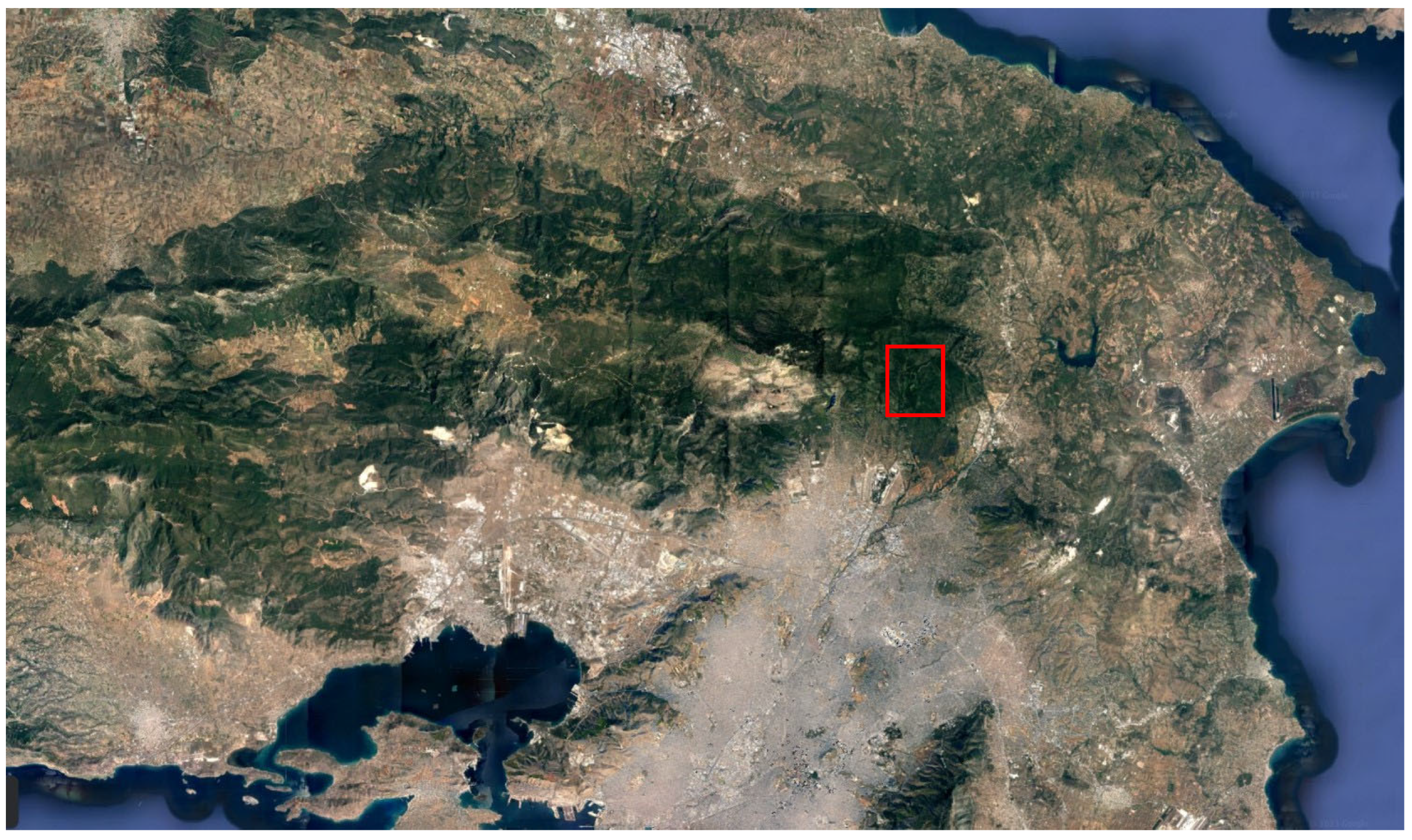
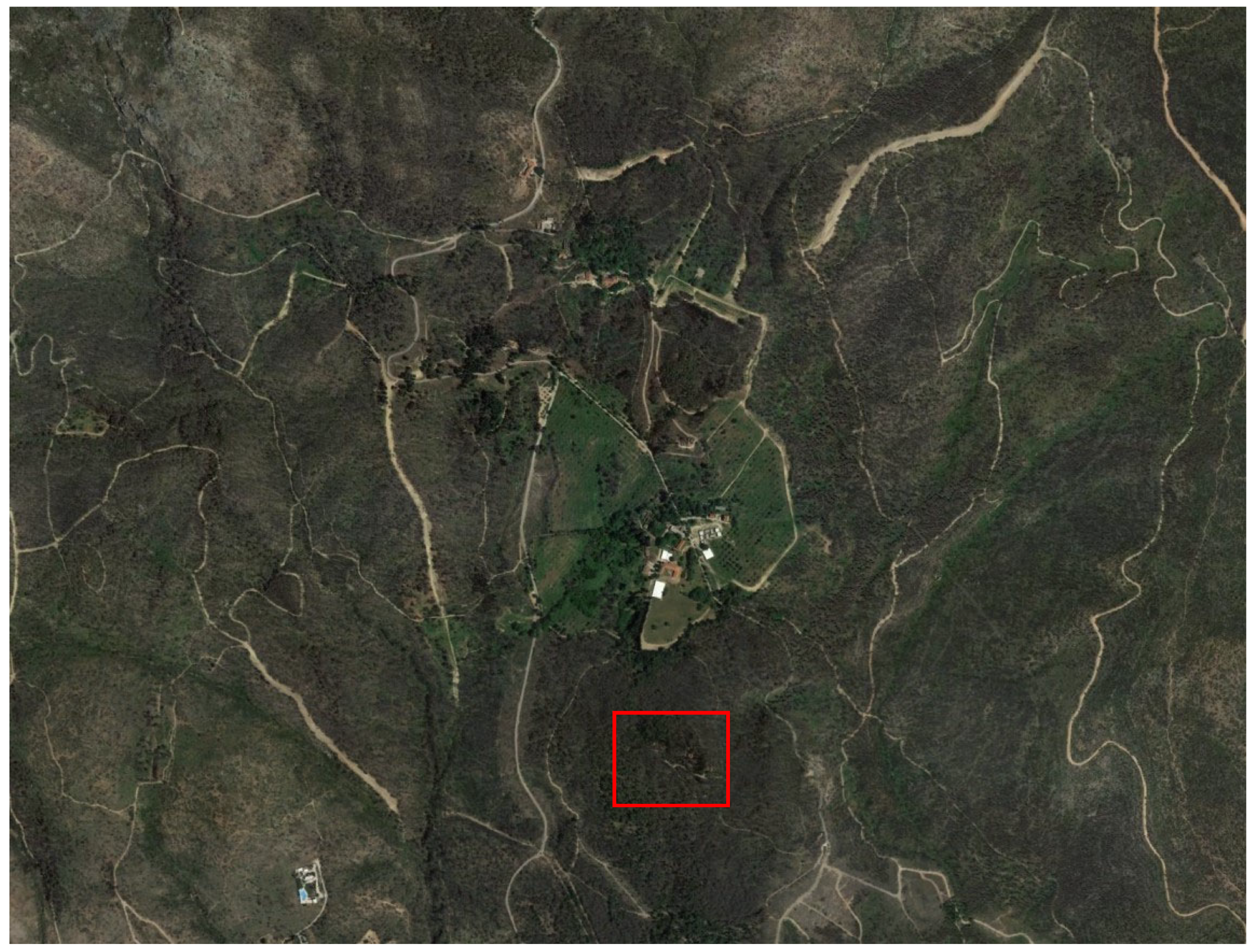
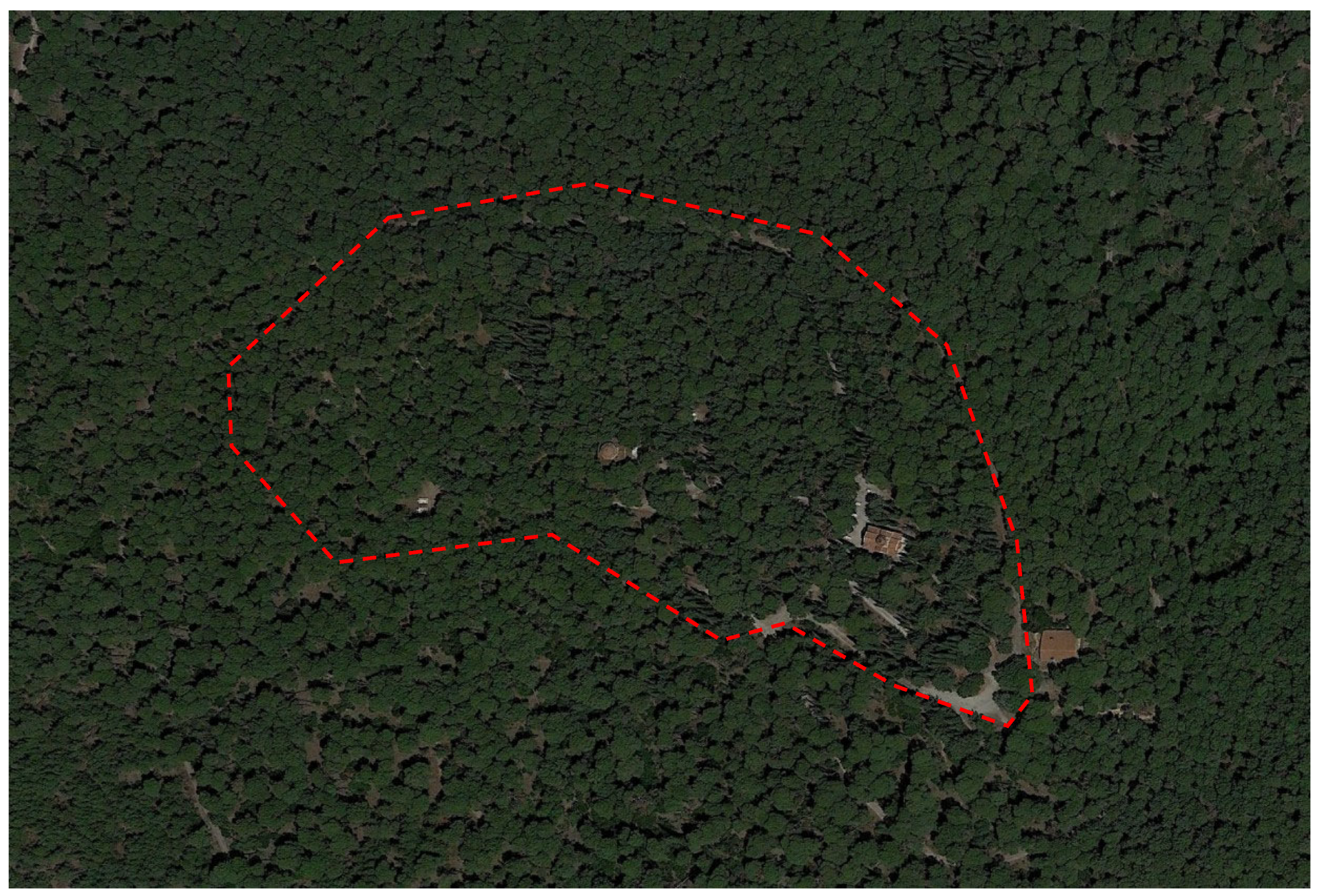
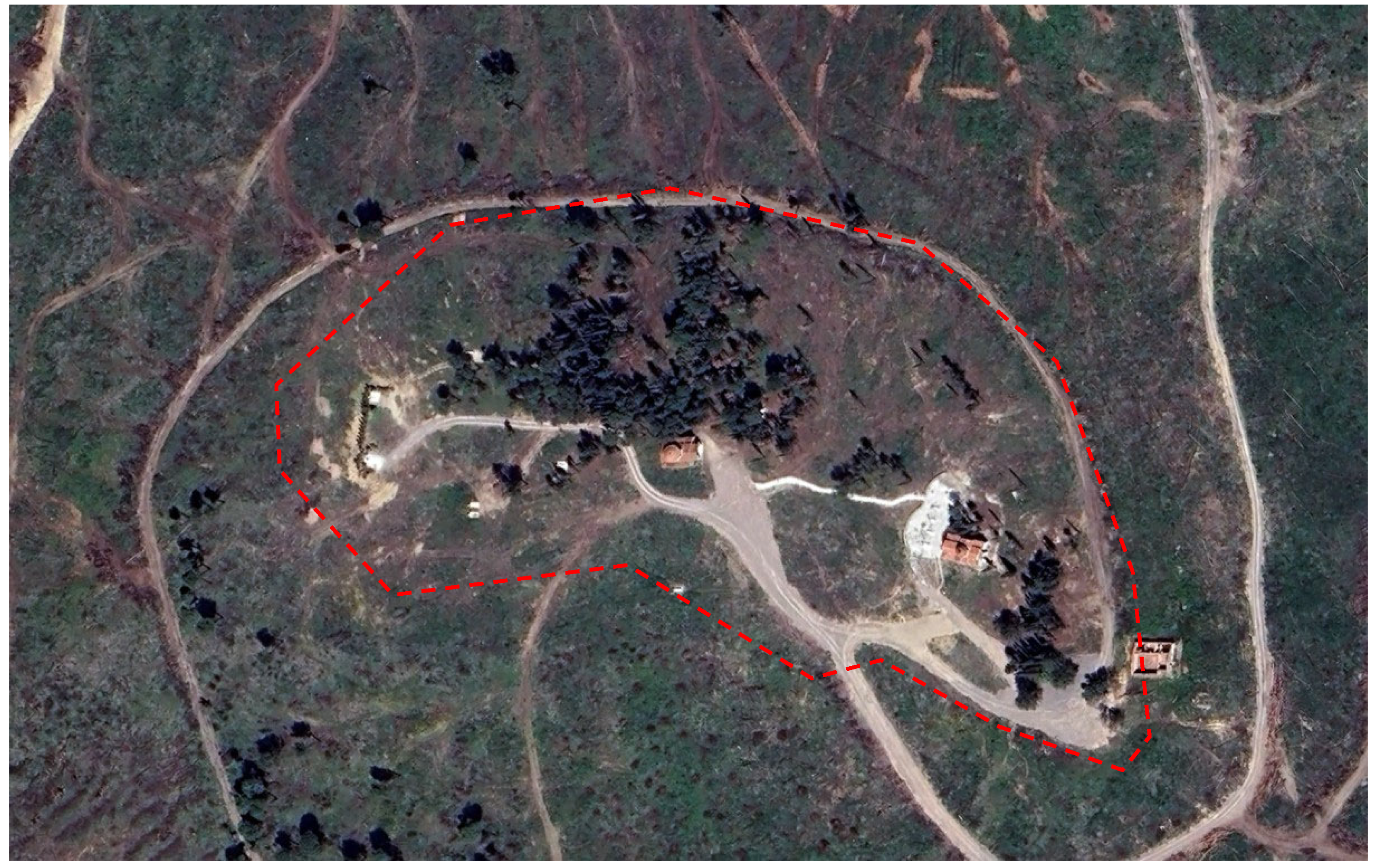

| Month | Air Temperature (°C) | Rain (mm) |
|---|---|---|
| January | 7.4 | 67.5 |
| February | 7.8 | 50.9 |
| March | 10.1 | 49.7 |
| April | 14.3 | 24.6 |
| May | 19.7 | 23.2 |
| June | 24.7 | 10.3 |
| July | 27.0 | 10.9 |
| August | 26.6 | 5.5 |
| September | 22.2 | 19.2 |
| October | 17.1 | 51.3 |
| November | 12.5 | 59.2 |
| December | 9.0 | 79.7 |
Disclaimer/Publisher’s Note: The statements, opinions and data contained in all publications are solely those of the individual author(s) and contributor(s) and not of MDPI and/or the editor(s). MDPI and/or the editor(s) disclaim responsibility for any injury to people or property resulting from any ideas, methods, instructions or products referred to in the content. |
© 2025 by the authors. Licensee MDPI, Basel, Switzerland. This article is an open access article distributed under the terms and conditions of the Creative Commons Attribution (CC BY) license (https://creativecommons.org/licenses/by/4.0/).
Share and Cite
Kanellou, E.; Doxiadis, T. Post-Fire Restoration of the Vegetation at the Cemetery of the Tatoi Estate Historical Site. Architecture 2025, 5, 7. https://doi.org/10.3390/architecture5010007
Kanellou E, Doxiadis T. Post-Fire Restoration of the Vegetation at the Cemetery of the Tatoi Estate Historical Site. Architecture. 2025; 5(1):7. https://doi.org/10.3390/architecture5010007
Chicago/Turabian StyleKanellou, Electra, and Thomas Doxiadis. 2025. "Post-Fire Restoration of the Vegetation at the Cemetery of the Tatoi Estate Historical Site" Architecture 5, no. 1: 7. https://doi.org/10.3390/architecture5010007
APA StyleKanellou, E., & Doxiadis, T. (2025). Post-Fire Restoration of the Vegetation at the Cemetery of the Tatoi Estate Historical Site. Architecture, 5(1), 7. https://doi.org/10.3390/architecture5010007






